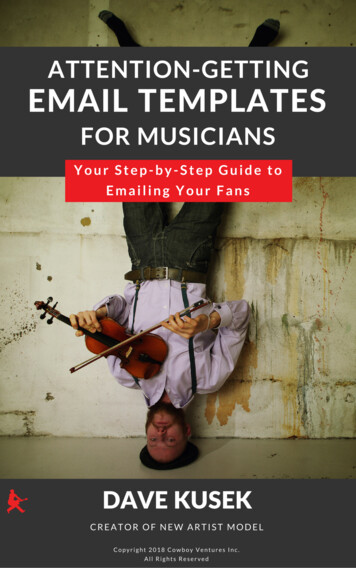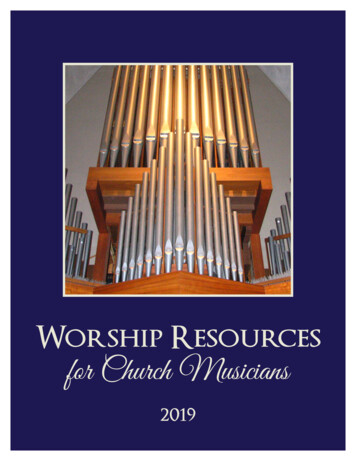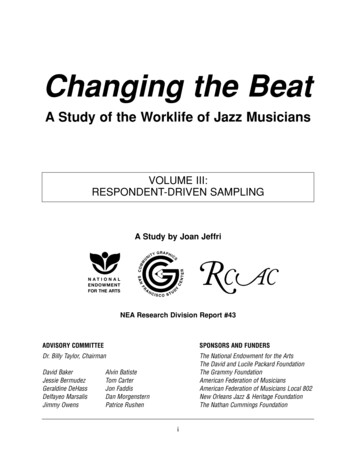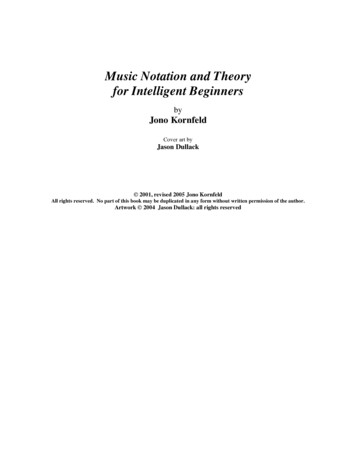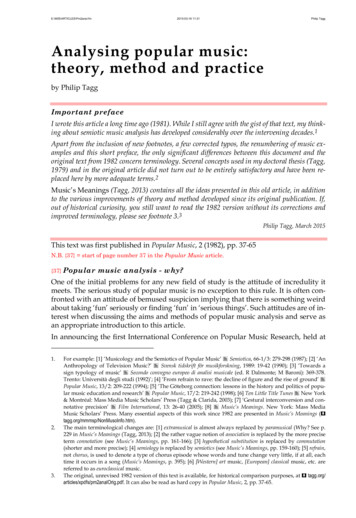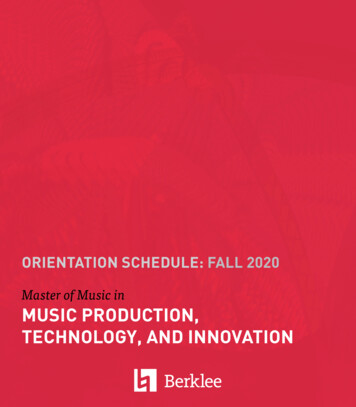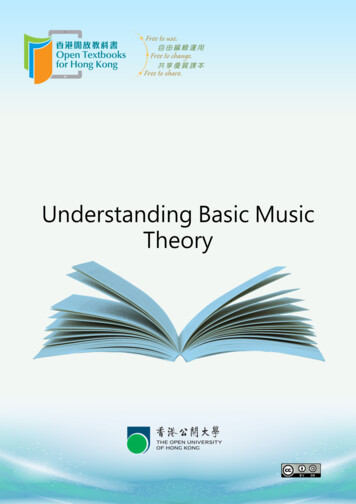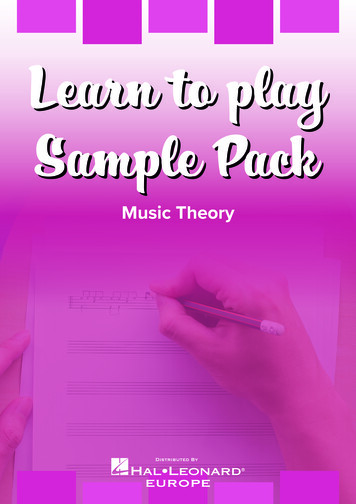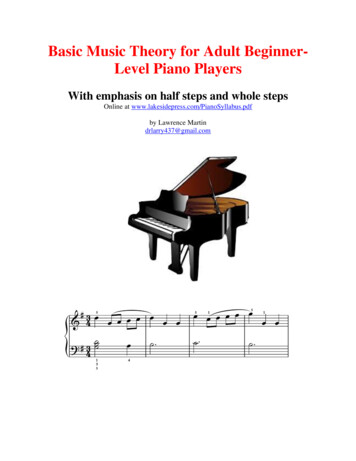
Transcription
MUSICTHEORYforThis file was Created onmarch 10, 2016!hello!this file is a collection of individual sheetscovering a bunch of lessons on music theory.MUSICIANSit’s not a book. yet. it might be someday!but as of right now, it’s incomplete.The truth is, they weren’t intended tobe a single volume when I started making them.they were just review sheets for my owntheory students.but the more I made,the more I realizedthey could be collectedinto a textbook of sorts.eventually!andNORMALI still have a lot of work to do,but I’ve collected the ones I’ve madeso far into a single document tomake it easier for the folkswho wanted them all. but didn’t wantto download every file individually!so understand it’s a work inprogress. the progress is slowsometimes, because I teach music theoryand aural skills during the day at theuniversity of dayton in dayton, ohio,and then head home to spend time withmy wife and six kids!PEOPLEso if you’ve been sent this fileby someone, know that theremight be a newer version —or more pages —at tobyrush.com.but if you like this,or find it useful,great! feel free toshare it, copy it, and use it.“My Dad”Sofia Rush, Age 5Pen and crayon on printer papernow let’slearn somemusic theory!just don’t sell it, change it,or tell others you made it!*by Toby W. RushRush*for more info, see http://creativecommons.org/licenses/by-nc-nd/4.0/
music theory for musicians and normal people by toby w. rushWhat is Music Theory?so then thebassoon choircomes in like flaminghoneydew melonsfrom on highChances are there’s a piece of musicthat moves you in a profound way.a way that is frustratingly difficultto describe to someone else!Like other forms of art, music often has the capabilityto create emotional reactions in the listener thattranscends other forms of communication.though a single piece of musicmay elicit different reactionsfrom different listeners, anylover of music will tell you thatthose feelings are real!pleasebradleyit’s lateand ifthey’re real,they’re worthyof study.one of the most valuable partsof music theory is giving names tomusical structures and processes,which makes them easier to talk about!i’malmostdonecoming up with terminologydoesn’t just help us talk toothers about music, though.it actually helps us learn!but while it’s an important step, and a great place to start, music theory ismuch more than just coming up with names for things!when composers write music — whether it’s a classicalera symphony or a bit of japanese post-shibuya-keiglitch techno — they are not following a particularset of rules. If anything they are often trying tobreak them!mozartso while a lot of people think music theory is aboutlearning the rules for how to write music, that’s notquite right. music theorists don’t create rules forwriting music; they look for patterns in music that isalready written.composerscreate.theoristsanalyze!which leads to the most importantquestion. the one that, as youstudy music theory, you should beconstantly asking yourself:because somewherein there is the reasonwhy that piece of musicmoves you.why?maybe it’s in the notes.maybe it’s in the silence.maybe it’s somewherein between.the reason itmakes you cry,gives you chills,reminds you of home.nakatait may take along time, oreven createmore questionsthan answers.why dissect music? what’s thepoint of figuring out rulesthat composers themselvesweren’t even worried about?butmusic theoristsare going tomusic theory isfiguring out whatmakes music work.find it,because.And you justjoined the team.grab your stuff.let’s go!licensed under a creative commons BY-NC-ND license - visit tobyrush.com for more
music theory for musicians and normal people by toby w. rushNotation: Pitch#¶#g#F#d#DµD#SµS#d#Mf#SµSµg#F œ œ œ œ œ œ œ œ œ œ œ œ œ œ Œmusic notation is the art ofrecording music in written form.liz phair“what makes you happy” [melody from chorus]whitechocolatespaceegg (1998)modern music notation is a productof centuries of transformation.and it is neither efficient nor intuitive!the system of musical notationwe use is essentially a stylizedgraph of pitch versus time.&pitch is the highness orlowness of a sound.the five lines on which notesappear is called a staff.pitchpitchfor example, a flute hasa high pitch, while a tubahas a low pitch.œ œ œ œ œœ œ œtimea note is awritten representationof a particular pitch.notation is based on the piano keyboard;lines and spaces on the staff representthe white notes on the keyboard.to display notesoutside thestaff, we useshortenedstaff linescalledledger lines.& wtreble clefBwalto clefF g a b c d e F g a b c d ethe white notes on the keyboardare labeled with letters from A to G.B wtenor clef?wbass clefthe clef determines what notes each staffline corresponds to. the four modernclefs are shown here; the note displayedon each staff corresponds to middle c.To notate theblack noteson the pianokeyboard, we useaccidentals,which alter thenote by one ortwo half steps.a half step isthe distancebetween twoadjacent keyson the pianokeyboard,regardlessof what colorthe keys are.‹#nb middle c is the c that is closest tothe middle of the piano keyboard.The double sharp raises thenote by two half steps.The sharp raises thenote by one half step.The natural cancels outany previous accidental.these symbols are placed tothe left of the note that theyaffect, and they apply to all thenotes on that line or spacefor the rest of the measure.& bœ œ nœ # œ œ œ nœ ‹œThe flat lowers thenote by one half step.F g a b c d e F g a b c d eThe double flat lowersthe note by two half steps.two notes which have the samepitch (for example, f sharp andg flat) are called enharmonics.licensed under a creative commons BY-NC-ND license - visit tobyrush.com for more
Notation: Rhythm a rest is a period ofsilence the length ofwhich corresponds to aparticular note.ties are curved marks which connecttwo notes together to createa single, extended sound.jœ œ œ.œ œ œfor example, these aren’texactly quarter notes;they are each a third aslong as a half note.one-hundredtwenty-eighth noteack!Get it off!GEt it off!to tie more than two notes together,draw ties between each note; do notuse a single, extended tie.œ œ œ œœ œ œ œmost tuplets are simple divisions, likethe triplets to the left. but anything ispossible! chopin, for example, wouldoften go to town with these things.62, no. 1 (1846)frederic chopinb major, op.nocturne ina tuplet is any non-standard division of anote. these are usually written as a groupof notes delineated with a bracket anda number showing the division being made.3multiple dots can also be added,each one adding half of thepreviously added value.K q. q e x xq. q e xj jœ œ œÂusually rests areplaced on the staff at aparticular verticalposition as shown here.the augmentation dot is a dot placed to theright of a notehead. though small, this dotwields some serious power: it adds halfof the original note’s length!q. q eÙone-hundredtwenty-eighth rest note lengths in a pieceare indicated by the tempomarking at the beginningof a piece or section.thirty-second rest‰sixteenth restŒeighth rest quarter rest half rest„whole restdouble whole restin this chart, each successive type of note is half as longas the note to its left. none of these notes has a standardlength; a half note in one piece may be the same length asan eighth note in a different piece.sixty-fourth notexKKKKx x xsixty-fourth restesixteenth noteqthirty-second notewhile pitch is pretty clearly notated on avertical axis, note length is indicated using asomewhat arcane system involvingnoteheads, stems and flags.eighth notehquarter notewhalf noteWwhole notedouble whole notemusic theory for musicians and normal people by toby w. rushlicensed under a creative commons BY-NC-ND license - visit tobyrush.com for morewha. gah!chopin, no!down, boy!
music theory for musicians and normal people by toby w. rushthe corrs“heaven knows” [drum intro]forgiven, not forgotten (1996)Notation: Meterthere are two types of beat units:those containing two divisions,called simple beat units.a fundamental feature ofmost pieces of music is aconsistent rhythmic pulse.this pulse is called the beat,and a single pulseis called a beat unit.qE Eq.E EE.and those containingthree divisions,called compound beat units.in music, beats are organized into patterns of accented and unaccented beat units.in fact, if you listen to a sequence of repeated notes, your brain will probably start toperceive the notes as groups of two, three, or four, even if no accents are present!Q Q Q Q Q Q Q Q Q Q Q Q Q Q Q Q Q Q Q Q Q Q Q Q Q Q Q Q Q Q Q Q Q34these groups are called measures,and they are delineated with barlines.the organizationof beat unitsand measures ina piece is calledmeter. Meter isdescribed by twonumbers placedat the beginningof the piece:the time signature.68barlinemeasure3 QQQ QQQ4simple TIME SIGNATURES are easy.the top numberindicates the numberof beats in a measure.the bottom numberindicates the type ofnote which serves asthe beat unit.2the code for the bottom noteis pretty easy: 4 refers toa quarter note, 8 to an eighthnote, 16 to a sixteenth note,and so on.6 Q. Q. Q. Q.8compound TIME SIGNATURES are kind of lying to you.the top number indicates the numberof divisions in a measure. to get thenumber of beats, divide it by three.the bottom number indicates the type ofnote which serves as the division.to get the beat unit, use the note thatis equal to three of these notes.in a compound meter, the beat unit isalways a dotted note!by looking at the topnumber of the time signature,you can tell two things aboutthe meter: whether it’s simpleor compound, and how manybeats are in a measure.234beats per measuresimple2346912in fact, wouldn’t this bean easier way to notatecompound meters?sorry. the man saysyou have to do itthe other way.notes that have flags canbe grouped together by usingbeams in place of flags.compoundhowever, beaming is only used to group notes within beats.for the most part, you shouldn’t beam notes between beats,nor should you tie notes within beats.licensed under a creative commons BY-NC-ND license - visit tobyrush.com for more
Hey, it’skids!music theory for musicians and normal people by toby w. rushSparky the music theory dog!Dear Sparky:understand that we’re supposed to beam rhythms to show the organization ofQ: Ibeatsin the measure, but is there an easy way to beam complex rhythms?--A.Y., Owatonna, MNA: WOOF!*notes should be beamed in groups that illustrate themeter. for simple rhythms, this is pretty easy to do;simply group any notes that can be beamed (eighth notes and smaller) intogroups that are equal to the beat unit of the current meter.*translation:& 43 œJ Jœ Jœ œJ œJ Jœ& 43 œ œ œ œ œ œfor complex rhythms, however, things can get complicated. when a rhythm includes thingslike syncopations or other off-beat figures, illustrating the meter may involve dividingnotes across beat units with ties. fortunately, there is a step-by-step system for correctlybeaming these complicated rhythms!for example, let’stake this rhythm,which is writtenwithout beaming.& 44 Jœ .œJœœRœRœRœJœRœRstep 1:find the smallest note value used, and fill a complete measure with this type ofnote, beamed in groups that are equal to a beat unit in the current meter.step 2:add ties between individual notes to recreate the original rhythm. make sure thateach tied group corresponds to a note in the rhythm you started with!& 44 œ œ œ œ œ œ œ œ œ œ œ œ œ œ œ œyes, i know itlooks weird.but we’re notdone yet!& 44 œ œ œ œ œ œ œ œ œ œ œ œ œ œ œ œ4 œ.4Joriginal rhythm:step 3:don’ttouch!œœRœRœRœœœœJœRœRfind every group of two or more notes that are both tied together andbeamed together, and replace them with a single note of equivalent value.if you have notesthat are tied orbeamed, but notboth, then leavethem alone!œ œJ JœJœ œhandsoff!& 44 œ .œ œ œyes.simplify it!œœœ.œœ.œa correctly beamed rhythm may include ties, but it willvery clearly show the beats in the measure. which, inturn, makes it easier for the performer to read!DOING STUFF THE SPARKY WAY IS ALWAYS FUN!licensed under a creative commons BY-NC-ND license - visit tobyrush.com for more
music theory for musicians and normal people by toby w. rushThe Majorœ Scaleœ#œ3œœœœ&4one of the reasons that a particular piece ofmusic sounds the way it does has to do with thegroup of notes the composer decided to use.johannMinuetnotebook sebastianinGformajorbachannamagdalenabach,1722œ œ œ œ œ œ œ œ œ œ œ œ œ œ œ œ œ œ œ œ œ œ œ .take this melody, for example.let’s first remove all the duplicate notes, regardless of which octave they’re in.œ #œ& 43 œœ œ #œ œ œ œ œœœ œ œœ #œ œœœœœœnext, let’s put the notesin alphabetical order,starting on the notethat the melody soundedlike it was centering on.œ#œœœœ œ œ œwhat we end up withis the “palette” forthis particular piece.there are actually manydifferent types of scales,each with a different patternof whole steps andhalf steps.a half step is thedistance betweentwo adjacent keyson the piano keyboard,regardless of color.like the board on which a painter holdsthe bits of paint being used in the paintingbeing created.in music, this “palette” is calleda scale. though we usually writescales from low to high, the order is actuallyunimportant; it’s the notes contained in thescale that help make a piece soundthe way it does.this particulararrangement, wherehalf steps occur betweensteps three and four and between steps seven and eight(or between seven and one, since eight and one are thesame note), is called the major scale.œ#œœœœœœ estephalfstepa whole step is theequivalent oftwo half steps.(this scale, by the way, is called theg major scale, because it starts on g.)knowing this formula, you can create a major scale on any note!&œœœ bœthe f major scale&œ œœœ#œ #œ œ#œœ#œ#œœthe b major scale& bœ bœ œ bœ bœ bœ œ bœthe g flat major scalebœ œ bœ& bœ bœ bœ bœ bœthe d flat major sca
let’s go! music notation is the art of recording music in written form. modern music notation is a product of centuries of transformation. and it is neither efficient nor intuitive! b n # ‹ Notation: Pitch #¶#g#F#d#DµD#SµS#d#Mf#SµSµg#F œœ œ œ œ œ œ Œ pitch is the highness or lowness of a sound. the system of musical notation we use is essentially a stylized graph of .

